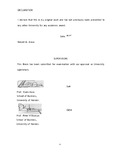| dc.description.abstract | Various writers have postulated that strategic planning enhances organizational
performance. Findings from previous studies also indicate that there is a
relationship between strategic planning and firm performance. However, certain
gapsare observed in these studies, which if attended to, according to the author
could provide more insight into the relationship being examined. It has been
observed that the past studies focused on the direct relationship between
strategic planning and performance without taking cognizance of the fact that
there are other factors that could influence the relationship being examined. It
is expected that strategic planning gives rise to some potential advantages and
intrinsic values especially within the short term, whose attainment status is
critical in facilitating the implementation and eventual realization of the
strategic planning objectives and goals. Various writers have also argued that
participation and involvement by management and other workers in the strategic
planning process could influence the realization of the expected strategic
planning outcomes. These dimensions were not given attention by the previous
studies.
Our study set out to examine the: relationship between strategic planning and
firm performance, relationship between strategic planning and strategic planning
intermediate outcomes, relationship between strategic planning intermediate
outcomes and firm performance, influence of employee participation in the
strategic planning process on the relationship between strategic planning and
strategic planning intermediate outcomes, and the relationship between
employee participation and firm performance.
The initial intention was to carry out a survey of all the 43 insurance companies
listed by Association of Kenya Insurers (2006) and operating in Kenya. However, '
only 31 companies participated in the study. The study involved collection of
data from across the firms within the Kenya's insurance sector. A survey design
was thus used as it was considered the" most appropriate for this kind of study.
The interviewees consisted of staff designated manager levels and above. A
structured questionnaire was used to gather the required data. To test the
formulated hypothesis, correlation analysis technique was used.
Findings indicate that strategic planning is practiced across the firms studied.
However, the extent of embracement varied from firm to firm. Results of data
analysis revealed the existence of a relationship between strategic planning and
firm performance within the studied sector with a Pearson correlation
coefficient of 0.616 implying the existence of a strong correlation between the
two variables. The result of the analysis also reveals the existence of a strong
correlation between strategic planning and strategic planning intermediate
outcomes (r = 0.716). Further, there is a link between strategic planning
intermediate outcomes and the subsequent company performance (r = 0.704).
There appears to be a stronger liDk between strategic planning intermediate
outcomes and non-financial performance (r = 0.777) compared to the one with
the financial indicators (r = 0.644). Analysis results also indicate that employee
participation indeed does influence the strength of the relationship between
strategic planning and strategic planning intermediate outcomes. This is
reflected by the falling Pearson correlation coefficient from 0.716 to 0.465 when
controlling for employee participation. A further analysis reveals that there is a
correlation between employee participation in the strategic planning process and
overall firm performance (r = 0.750). All the correlations are statistically
significant at the 1 percent level. From the study findings, it can be inferred
that there is a relationship between strategic planning and firm performance
regardless of context. It can also be said that indeed employee participation in
the strategic planning process does moderate the relationship between strategic
planning and strategic planning intermediate outcomes. This moderating effect is
supported by the finding that there is a link between employee participation and
firm performance.
To the research community, this study opens a window for further studies
towards gaining more insight into the subject area of strategic planning. These
include: a study recognizing competence and skills of those driving the practice;
examination of externally/internally driven strategic planning process in terms of
effectiveness of the process against its expected deliverables; and a similar
study to ours but incorporating other workers in addition to management as
respondents. For policy makers and managers, this study is a pointer to the fact
that the way the process of strategic planning is managed has a bearing on the
realization of its expected outcomes. Participation and involvement of
employees in the strategic planning process need be considered as crucial for an
organization to effectively realize the strategic planning intentions. Top
management involvement and commitment is key as the strategic leadership is
required to drive the process.
This study had its limitations and challenges. No similar studies had been carried
out in this subject area in Kenya, implying inadequate relevant literature
particularly on the new dimensions brought in. Secondly, there was a general
tendency by some firms of not willing to particjpate. Thirdly, some of the
information required were not either readily available or the respondents were
unwilling to divulge the same. This is in particular to financial data on
performance. The administration of questionnaires and interviews proved a very
cumbersome and tiring exercise as this was undertaken by the researcher
personally. There were also resource constraints particularly in terms of time
and funding. Only the top management was targeted as respondents implying the
rest of the employees' perceived perspectives were not captured or considered. | en |

